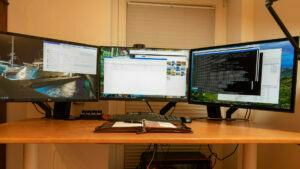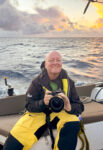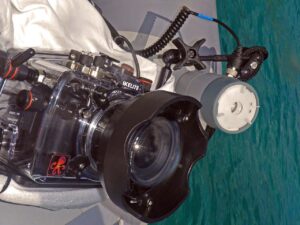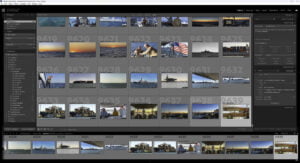Software and hardware used for this Site
A surprising amount of software and hardware is required to create, maintain, and expand this website. Most of the software products that I use are free, but the important software is not free – the Windows operating system, website hosting, and the Adobe Lightroom photo management system. Here’s a list of all the hardware and software I use for this website:
Hardware
Computers

I have an older, but still powerful, computer that drives a nice setup at home. While the processor is a fast AMD with 16 cores, the graphics card is a somewhat outdated NVIDIA GeForce 1070 Ti, which drives my 3 32″ 4K monitors. This setup allows me to have several windows open at the same time and to edit my pictures with ease.
My setup on the boat is smaller. I have a Gigabyte Brix barebone computer and a smaller monitor; this makes it a bit less comfortable to work, but it is still a big jump up from my backup system, an older notebook.
Cameras

I use a Nikon D850 camera for all my pictures and have several lenses that I choose from, although my main workhorse lens is the AFS Nikkor 24-70 VR 2.8. The camera is a professional-level and in more skilled hands, it would take much better pictures. But I compensate for my lack of skill by taking lots of pictures and then selecting the best of the litter.

I use my old Nikon D7100 for my underwater pictures, with an Ikelite underwater housing. Taking pictures underwater is surprisingly difficult. Often, all you see is reflections from suspended particles or just “fish butt” pictures as the fish swim away from you. But that 1 in 100 picture that does turn out is worth the effort.
Software
 Bluehost Hosting
Bluehost Hosting
After the fiasco with my previous hosting provider, I searched around the web for a suitable replacement that was reliable, inexpensive, and included WordPress as part of the package. I transferred all of my domains to the new company and host some sites there as well; but these pages are by far the biggest in terms of both file size and content. Bluehost has been, overall, a good provider with fast support.
 Microsoft Windows 11
Microsoft Windows 11
I use UNIX and various Linux implementations for work and generally prefer that operating system over Microsoft Windows. But I’ve been using Windows and the Microsoft Office Suite of programs for over 30 years, so I’m accustomed to it and am too lazy to change over. I still recall installing Windows and Office using about 30 3.5″ floppy drives!
 WordPress
WordPress
WordPress has established itself as the largest CMS (content management system) for the web with over 35% of the market share. It offers a lot in the free version, and there are literally thousands of different add-ons (called plugins) on offer. Many of those are free or have limited-functionality free versions; while others are very sophisticated and can cost quite a bit of money. Since I’m not in the blog business for money, I use the free versions of the plugins with one exception, Elementor Pro.
Initially I found the system a bit confusing and overwhelming, but after using it for a while I can see how it caters for all developers ranging from rank beginners such as myself to professionals who make their living within the ecosphere of WordPress
 WordPress Plugins
WordPress Plugins
 WordPress Plugins
WordPress Plugins- Akismet Anti-spam
- APCu Manager - performance, cacheing
- BEAF - Ultimate Before After Image slider & Gallery
- Broken Link Checker - find non-function external links
- Connect Polylang for Elementor - Enable multiple languages
- Duplicate Menu - duplicate WordPress Menus
- Elementor - page designer
- Elementor Pro - add-ons for Elementor
- FileBird Lite - organize media into folders
- Hot Random Image - display a random image
- Litespeed Cache - optimize page presentation speeds
- Media Library Assistant - Enhance the media library
- Polylang - allow multiple languages on the site (see Farewell German Pages)
- Redirection - manage 301 and 404 redirections
- Site kit by Google - measure visitor statistics
- TablePress - enable interactive tables
- TablePress Row Details - add row details functionality (became chargeable)
- TaxoPress - manage tags, categories and other taxonomy
- Bluehost Plugin - required for the hosting process
- Updraft Plus - backup and restore the WordPress site
- WP Go Maps - create interactive maps
- WP External Links
 Adobe Lightroom Classic
Adobe Lightroom Classic

I use Adobe Lightroom Classic for all of my picture administration and formatting. While it started life mainly as an organizational tool for large photo collections, the software currently contains many advanced editing features and for all of my photo editing it completely replaces Adobe Photoshop. The classic version is what runs on Windows, there is also a cloud version included in my software plan, but I’ve never tried it.
 FileZilla
FileZilla
While WordPress is a great front-end that allows uploading and downloading from within the CMS, sometimes it is still necessary to use FTP and FileZilla is a great graphical front-end for that. I spent years using the command line version of FTP with “connect”, “get” and “put” commands, so I know how much better this front-end really is.

 OpenCPN
OpenCPN